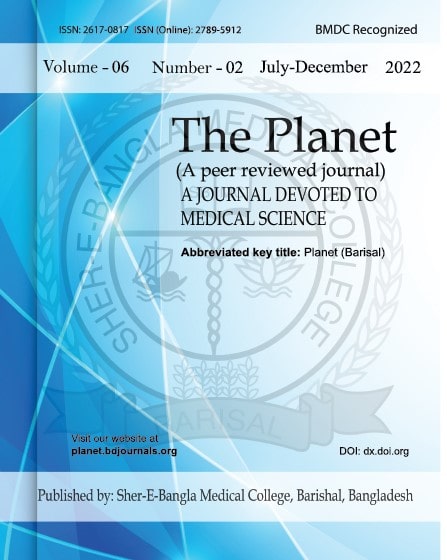Abstract
Introduction: Childhood leukemia and lymphoma are twocommon malignancies that cause morbidity and mortality.Acute lymphoblastic leukemia (ALL) is the most prevalenttype, while non-Hodgkin lymphoma (NHL) is the thirdmost common. Treatment for these malignancies oftenincludes high-dose methotrexate (HD-MTX), which cancause significant toxicity. MTHFR gene polymorphismshave been linked to increased toxicity. This study aims todocument the biochemical abnormalities associated withHDMTX toxicity in children. Methods & Materials: Thisstudy was conducted prospectively in the Department ofPediatric Hematology & Oncology at BSMMU in Dhakabetween July 2015 and December 2015. The studypopulation included children under the age of 15 who werediagnosed with Acute Lymphoblastic Leukemia (ALL) orNon-Hodgkin Lymphoma (NHL) and were receiving high-dose methotrexate (HDMTX) aspart of their treatment. Results: The study population consisted of 30 patients with childhoodmalignancy, with Acute Lymphoblastic Leukemia (ALL), being the most common malignancy76.7% followed by non-Hodgkin lymphoma 23.3%. Biochemical toxicities such as elevatedtransaminases and raised creatinine were observed in 6.7% and 3.3% of patients,respectively, but no neurotoxicity was reported. Hematological toxicities such as neutropenia and thrombocytopenia were observed in 26.7% and 3.3% of patients, respectively, with ahigher occurrence in cycles 2 and 3 compared to cycle 1.Hematological recovery occurredby day 12 in most cases. Conclusion: This study found that elevated transaminases andraised creatinine were the major biochemical toxicities associated with HDMTX infusion,while neutropenia and thrombocytopenia were the major hematological toxicities observed.

This work is licensed under a Creative Commons Attribution 4.0 International License.
Copyright (c) 2023 The Planet


 PDF
PDF